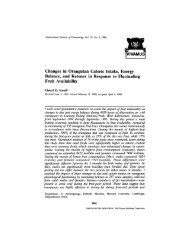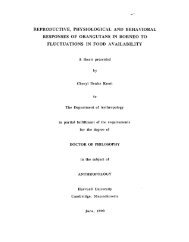Saving Gunung Palung: A Rainforest Marriage - Cheryl Knott
Saving Gunung Palung: A Rainforest Marriage - Cheryl Knott
Saving Gunung Palung: A Rainforest Marriage - Cheryl Knott
- No tags were found...
Create successful ePaper yourself
Turn your PDF publications into a flip-book with our unique Google optimized e-Paper software.
on academeHUMAN SUBJECTS/HUMANE RESEARCH:THEN AND NOWBy Janine Brunell LookerWalk into the lobby of WilliamJames Hall, which houses thepsychology department, andyou will find a sign reading, “SubjectsWanted.” The sign directs you to bulletinboards cluttered with various invitationsto participate in psychological researchprojects in exchange for nominal monetaryrewards. “Judge People for $$,”one reads. “Participants Wanted forPsychology Experiment on Memory”reads another.Seems harmless enough.Yet history has taught us that researchconcerning human subjects is as perilousas it is essential. Without such research,the advancement of knowledge in medicine,psychology, and sociology would besluggish, if not altogether impossible.Without it, treatments for cancer, therapiesfor psychological illnesses, andadvances in social understanding wouldbe nonexistent.Yet it is also true that without suchresearch, thousands would have beenspared atrocities and death at the handsof Nazi doctors during World War II, andhundreds of African-American men in theUnited States could have been cured ofsyphilis. The list goes on.This tension between the methods usedto advance scientific knowledge and thedamage these methods may inflict onindividuals has spurred the developmentof ethical standards concerning humanresearch subjects. And it was in reactionto science’s most flagrant offenses thatsuch codes of ethics were conceived.INSTITUTIONAL REVIEWDean Gallant is assistant dean forresearch policy and administration andexecutive officer of the Faculty of Artsand Sciences Standing Committee on theUse of Human Subjects in Research.“There were a number of cases in the1950s and ’60s where the abuse of humanresearch subjects led to the institution offederal regulations to protect these subjects,”he says. Among these was a studyof immune-compromised patients byresearchers who injected cancer cells into“an unwitting group of elderly people.Largely as a result of studies like this, federalrequirements were instituted to establishcommittees such as ours.”The Committee on the Use of HumanSubjects in Research is one of three suchinstitutional review boards (IRBs) atHarvard (the other two are within theMedical School and School of PublicHealth). IRBs approve all research proposalsinvolving human subjects thatwould be conducted at the University, andthey are also mandated to educate andinform researchers about the ethical complexitiesinvolved in human subjectresearch.IRBs also offer guidance for graduatestudent researchers. “There is a generalonline program offered to all researchersusing human subjects—required whenNIH funds are involved,” Gallant says.Harvard’s three IRBs, under the auspicesof the Provost, have just been awarded agrant by the NIH to expand and enhancethis online program, he says, includingdeveloping separate modules for differentdisciplines. In-depth instruction for GSASstudents in the ethics of human subjectsresearch is also integrated by departmentsinto students’ research training curriculum,Gallant adds.At the core of the standards adopted byHarvard and other research institutions isthe Nuremberg Code. It was establishedduring the 1946 trial of 20 physicianswho, “in the name of science,” performedexperimental procedures on concentrationcamp prisoners.The Nuremberg Code laid out ten conditionsto define the practice of ethicalresearch. Among these was a mandate forthe consent of subjects and for the worthinessof the research being considered.Elements of the Nuremberg Codeappeared in the code of standards setseven years later by the NationalInstitutes of Health (NIH). The NIHguidelines were established in response toallegations that American doctors wereperforming unethical research on humansubjects at hospitals and universities—as,for example, in the notorious Tuskegeeand Willowbrook studies.The Tuskegee Syphilis Study (1932–72)was a federally funded research project inwhich 400 African-American men withsyphilis were deceived into participatingin a study of that disease. During thecourse of the study, penicillin was discovered.Although the drug became widelyused as an effective treatment for syphilis,it was withheld from the subjects of theHarvard University4GSAS





